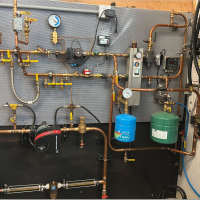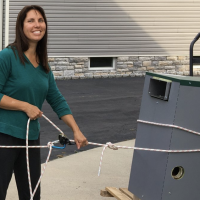What would cause such rapid destruction of valves?
I looked over my baseboard system heating plant for the first time in months. I noticed severe deterioration of a valve that only happened over the last year. Can anyone advise what would cause such rapid destruction of the metal? I grabbed a screenshot of it from about 14 months ago and it looked fine. Now it’s scary. What could be going on here lately?
Comments
-
-
-
The air vent is leaking.
Agreed, replace the x-tank as well
0 -
-
-
Speaking as a homeowner,
Galvanic Corrosion, also known as bi-metallic corrosion caused this.
If you are going to keep this plumbing as is-
When replacing the parts you should be using bronze fittings/pipe nipples etc. all the way back to the heavy wall pipe and tees, and a bronze shut off valve and bronze pipe nipples to shut the boiler water off from the pressure regulator as you should only be filling the system ONCE and shutting the water off and leaving it off. You also need a back flow preventer piped before the water feed and pressure regulator.
1 -
should I keep using that antifreeze if it’s that corrosive? It’s a summer house that we don’t get to much in the winter, so if the electric goes out on a very cold winter day, I don’t want the system to split open again and flood the house. This happened about ten years ago during a power outage.
0 -
Like most equipment in hydronic heating systems, antifreeze requires maintenance.
Testing its concentration & acidity should be done annually. We like about a 30% concentration. And, the leaking piping, fittings, or accessories should be fixed antifreeze tight.
The interesting thing about antifreeze is it will find an escape where air or water won't. A chemist told me it has to do with surface tension.
0 -
I have to ask if you have a freeze prevention valve on this boiler??? A boiler protection valve like this would have opened and it would have prevented freeze damage/expansion from occurring but it would not have prevented the galvanic corrosion.
0 -
I would not have a fill valve on a system with glycol. Use a fill tank. Or a separate expansion tank as a fill.
Air vents will spit some air and fluid from time to time, that is not unusual.
The glycol should be checked every few years Ph mainly. A test meter or test strips is all you need.
When the ph drops into the low 7 or below it is time to flush and replace the glycol.
Tough call on whether you really need or want it? Do you drain down the plumbing system in winter?
I would flush that system, run a hydronic cleaner, then refill with a 30- 35% premix glycol.
Bob "hot rod" Rohr
trainer for Caleffi NA
Living the hydronic dream3 -
With glycol in that system that automatic feed valve must be removed, the make up waterline disconnected to prevent any type of cross contamination of the potable water system
0 -
what do you think would cause all that within 14 months? I think the valve was in there over 40 years with no issue.
0 -
-
just water dripping like that would do it, the glycol is just a bonus.
since the leak has compromised all your old style air elimination, i'd replace all of it. i'd put in a modern microbubble separator in place of the air scoop, new expansion tank, and i'd use a caleffi prv if you are going that route but since you're running glycol the prv may not be what you want.
0 -
Most hydronic components are rated for 30- 50% glycol mix. I don't know that that fill valve is glycol approved?
Some of those Watts had a little rubber flapper as a check on the discharge, but it looks like glycol was inside that fill valve.
Hopefully there is a BFD as that glycol then could enter the homes water piping in the event of a low or no pressure condition.
Bob "hot rod" Rohr
trainer for Caleffi NA
Living the hydronic dream1 -
-
if the system is mostly unattended you might want to close the cap on the new automatic air vent after the initial fill and it has run for a few weeks to work the air out so it doesn't leak undetected for a couple years like the old one.
0 -
Chemistry says: If glycol becomes acidic, it becomes an electrolyte and your combination of iron, copper, brass, bronze becomes a battery or multiple batteries. The frost on top of your Fill valve is whitish and slightly blue? Not iron. Not copper. Maybe Zinc. The acid and electricity can bust the zinc out of copper-zinc brass over time. Maybe faster if more volts in the batteries. I suggest you measuring galvanic voltage and external voltages between all near and far parts of your heat system and plumbing pipes.
2 -
or cryo-tek
0 -
Any fluid, even plain water is an electrolyte. When they test for the galvanic chart they often use sea water, high conductivity water.
The white fuzz is sometimes called meringue, it is the minerals that precipitate out when the water evaporates. The green colored indicates the presences of copper in the precipitation. In addition a drop in ph has accelerated the corrosion, rusting.
When glycol is exposed to air, the inhibitors breakdown. Which is why you need to store it in a tightly sealed container, O2 ingress will ruin the fluid.
Bob "hot rod" Rohr
trainer for Caleffi NA
Living the hydronic dream2
Categories
- All Categories
- 87.3K THE MAIN WALL
- 3.2K A-C, Heat Pumps & Refrigeration
- 61 Biomass
- 429 Carbon Monoxide Awareness
- 120 Chimneys & Flues
- 2.1K Domestic Hot Water
- 5.8K Gas Heating
- 114 Geothermal
- 166 Indoor-Air Quality
- 3.7K Oil Heating
- 77 Pipe Deterioration
- 1K Plumbing
- 6.5K Radiant Heating
- 395 Solar
- 15.7K Strictly Steam
- 3.4K Thermostats and Controls
- 56 Water Quality
- 51 Industry Classes
- 50 Job Opportunities
- 18 Recall Announcements















